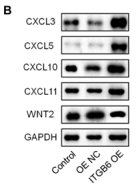GRO gamma Antibody - #DF8554
| Product: | GRO gamma Antibody |
| Catalog: | DF8554 |
| Description: | Rabbit polyclonal antibody to GRO gamma |
| Application: | WB IHC |
| Cited expt.: | WB |
| Reactivity: | Human, Mouse, Rat |
| Mol.Wt.: | 11 kDa; 11kD(Calculated). |
| Uniprot: | P19876 |
| RRID: | AB_2841758 |
Related Downloads
Protocols
Product Info
*The optimal dilutions should be determined by the end user. For optimal experimental results, antibody reuse is not recommended.
*Tips:
WB: For western blot detection of denatured protein samples. IHC: For immunohistochemical detection of paraffin sections (IHC-p) or frozen sections (IHC-f) of tissue samples. IF/ICC: For immunofluorescence detection of cell samples. ELISA(peptide): For ELISA detection of antigenic peptide.
Cite Format: Affinity Biosciences Cat# DF8554, RRID:AB_2841758.
Fold/Unfold
C-X-C motif chemokine 3; C-X-C motif chemokine ligand 3; Chemokine (C X C motif) ligand 3; Chemokine (CXC motif) ligand 3; Cinc 2; CINC 2b; Cinc2; CINC2b; CXCL 3; Cxcl3; CXCL3_HUMAN; Cytokine induced neutrophil chemoattractant 2; Dcip1; Dendritic cell inflammatory protein 1; Gm1960; GRO protein gamma; GRO-gamma; GRO-gamma(1-73); GRO-gamma(5-73); GRO3; GRO3 oncogene; GROG; Growth regulated protein gamma; Growth-regulated protein gamma; Macrophage inflammatory protein 2 beta precursor; Macrophage inflammatory protein 2-beta; Melanoma growth stimulatory activity gamma; Member 3; MGSA gamma; MIP 2b; MIP2-beta; MIP2B; SCYB3; Small inducible cytokine subfamily B;
Immunogens
A synthesized peptide derived from human GRO gamma, corresponding to a region within C-terminal amino acids.
- P19876 CXCL3_HUMAN:
- Protein BLAST With
- NCBI/
- ExPASy/
- Uniprot
MAHATLSAAPSNPRLLRVALLLLLLVAASRRAAGASVVTELRCQCLQTLQGIHLKNIQSVNVRSPGPHCAQTEVIATLKNGKKACLNPASPMVQKIIEKILNKGSTN
Research Backgrounds
Ligand for CXCR2 (By similarity). Has chemotactic activity for neutrophils. May play a role in inflammation and exert its effects on endothelial cells in an autocrine fashion. In vitro, the processed form GRO-gamma(5-73) shows a fivefold higher chemotactic activity for neutrophilic granulocytes.
N-terminal processed form GRO-gamma(5-73) is produced by proteolytic cleavage after secretion from peripheral blood monocytes.
Secreted.
Belongs to the intercrine alpha (chemokine CxC) family.
Research Fields
· Environmental Information Processing > Signaling molecules and interaction > Cytokine-cytokine receptor interaction. (View pathway)
· Environmental Information Processing > Signal transduction > TNF signaling pathway. (View pathway)
· Human Diseases > Infectious diseases: Bacterial > Salmonella infection.
· Human Diseases > Infectious diseases: Bacterial > Legionellosis.
· Organismal Systems > Immune system > Chemokine signaling pathway. (View pathway)
· Organismal Systems > Immune system > NOD-like receptor signaling pathway. (View pathway)
· Organismal Systems > Immune system > IL-17 signaling pathway. (View pathway)
References
Application: IF/ICC Species: Human Sample:
Application: WB Species: Mouse Sample:
Application: WB Species: Human Sample:
Restrictive clause
Affinity Biosciences tests all products strictly. Citations are provided as a resource for additional applications that have not been validated by Affinity Biosciences. Please choose the appropriate format for each application and consult Materials and Methods sections for additional details about the use of any product in these publications.
For Research Use Only.
Not for use in diagnostic or therapeutic procedures. Not for resale. Not for distribution without written consent. Affinity Biosciences will not be held responsible for patent infringement or other violations that may occur with the use of our products. Affinity Biosciences, Affinity Biosciences Logo and all other trademarks are the property of Affinity Biosciences LTD.


